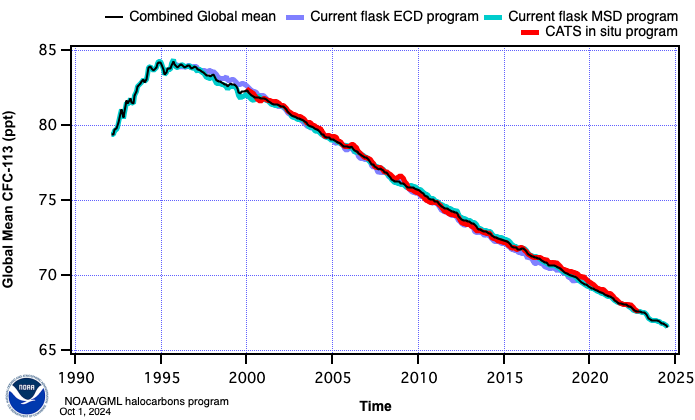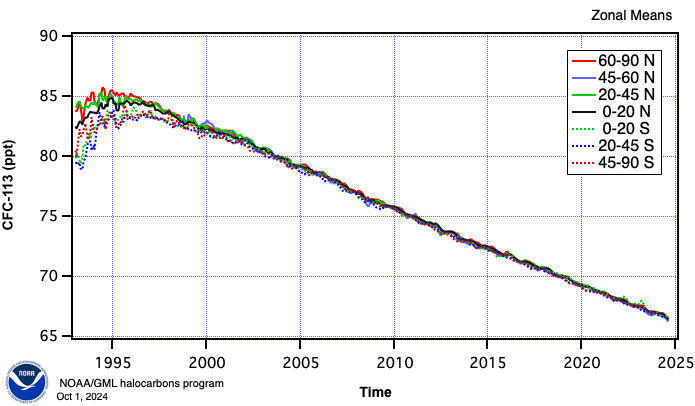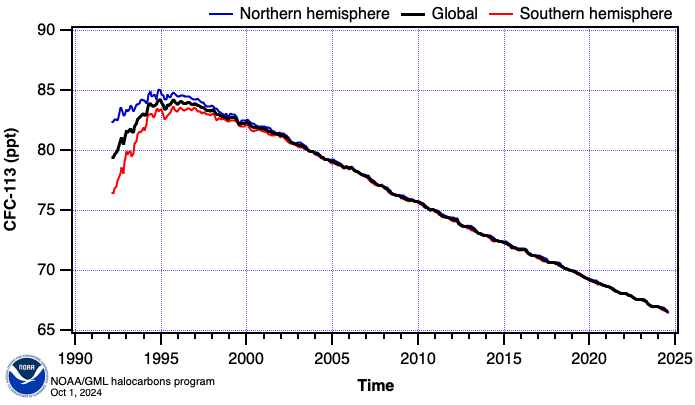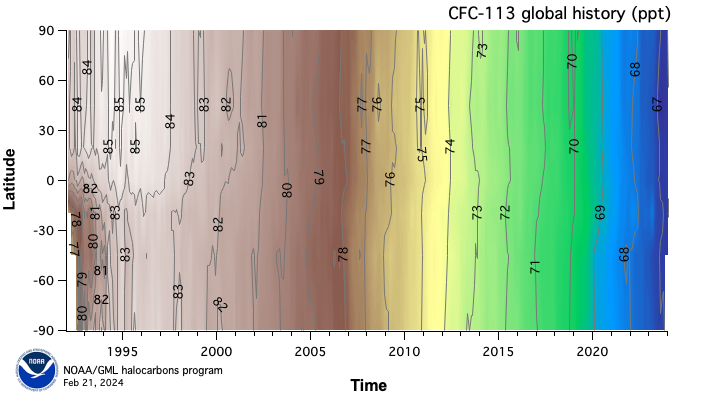Chlorofluorocarbon-113 (C2Cl3F3) - Combined Dataset
The GML Halocarbons and other Atmospheric Trace Species (HATS) group have been measuring chlorofluorocarbon-113 (CFC-113) with three separate programs since 1992. The programs include two flask systems using gas chromatography with either electron capture detector (ECD) or mass spectrometry detection (MSD) and one in situ ECD measurement program. Flask measurements started in 1977 with six locations and another nine added over the years. Currently, the flask program samples at 15 sites about once a week. In situ measurements of CFC-113 were started in 1998 with the CATS gas chromatographs that are currently installed at six remote field sites and make hourly measurements.
A combined dataset has been developed to incorporate all of the HATS monthly mean measurements made by each program. The combined dataset is calculated by taking weighted averages of co-located measurements from background NOAA/GML air measurement programs (listed below). All programs are on the same NOAA scale (NOAA 2002 scale for CFC-113), and every attempt is made to correct known biases between measurement programs; however, there may be small differences that are not understood and characterized.
When comparing measurements from station to station, be aware that not all locations are composed of the same measurement programs. The hemispheric and global means in the combined dataset are our best measure of long-term trends and are used for international and national assessments for background air measurements. Displayed below are the datasets used to produce the combined dataset as well as several figures.
There is a systematic difference between MSD and ECD measurements (both flask and in situ programs), where the ECD data is on average 1.5 ppt greater. Results from ECD instruments (OTTO and CATS) are adjusted for the combined dataset presented here. Follow the individual measurement program links at the bottom of this page for unadjusted data.
| CFC-113 measurement programs | Start | Finish |
|---|---|---|
| HATS MSD flask instrument (M1 and M3) | 1992 | Current |
| HATS ECD flask instrument (OTTO) | 1995 | 2019 |
| HATS in situ (CATS program) | 1998 | Current |
Current HATS programs (green rectangles) and discontinued programs (yellow rectangles) are used in the combined dataset. Click on a rectangle for a link to a specific program's data files.

The figure above shows the different measurement programs' calculated global means and illustrates the overlap amongst programs (current programs are solid lines, dashed lines are discontinued programs). Measured monthly means from the different programs are statistically combined to create a long-term NOAA/GML dataset (black line). The combined data is calculated by first interpolating missing data at sampling location for each measurement program. A weighted average is subsequently calculated where there are co-located measurements from two or more programs. The gap filled station measurement is then smoothed with the Savitzky-Golay algorithm.

Zonal means are calculated for four northern (solid lines) and three southern (dashed lines) bins.

Hemispheric and a global mean are calculated from the zonal averages where sampling locations are weighted by the cosine of their latitude. This combined CFC-113 dataset is used in NOAA's Annual Greenhouse Gas Index (AGGI) and NOAA's Ozone Depleting Gas Index (ODGI).

Global history of CFC-113 as function of a latitude (y-axis) and time (x-axis).
